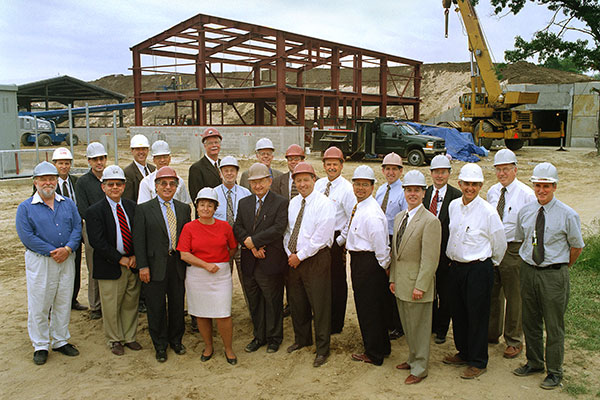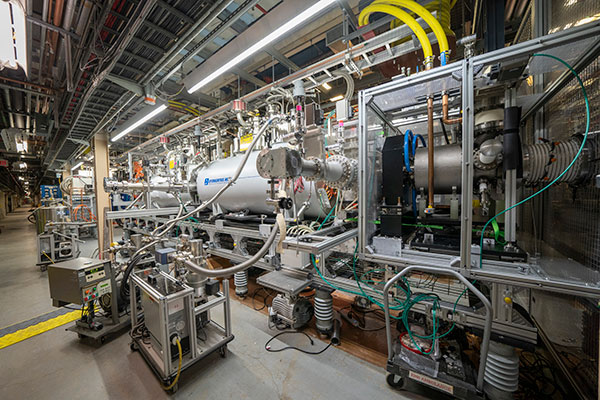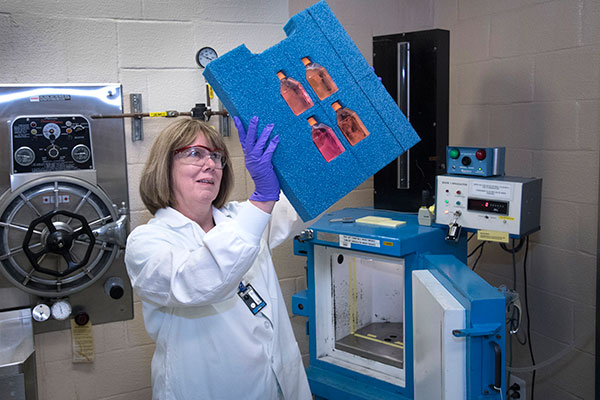Assessing the risks of space radiation to human space travelers
As the National Aeronautics and Space Administration (NASA) prepares for future missions to the Moon and Mars, many of the health risks of cosmic radiation are still uncertain. Before humans can travel for extended periods outside Earth's atmosphere, scientists must learn more about the risks posed by cosmic radiation. To better understand these risks, NASA has teamed with the U.S. Department of Energy's (DOE) Office of Science to establish the NASA Space Radiation Laboratory (NSRL) at DOE's Brookhaven National Laboratory. There, scientists use beams of ions to simulate cosmic rays and assess the risks of space radiation to human space travelers and equipment. NSRL features include:
Beams of all ions from protons to thorium, ranging in energy from 50 MeV to 1500 MeV (ion species dependent), and extracted from the Booster accelerator with masses and energies similar to the cosmic rays encountered in space
A 100-meter transport tunnel and beam line to deliver beams of simulated space radiation to a 400-squarefoot shielded target hall for NASA-funded space-effects experiments
A target hall connected to a 4,560-square-foot support building, which includes five laboratories for biological and materials experiments, as well as specimen and control rooms
User support from Brookhaven's Biology and Collider-Accelerator Departments
Space Radiation
Space radiation consists of different types of charged particles, such as protons and high energy heavy ions, that are emitted by the Sun and galactic sources. While our planet's magnetic field and atmosphere naturally block particles of space radiation protecting us on Earth, travelers beyond these natural shields are not protected. These particles move at nearly the speed of light and easily penetrate shuttle and space station walls, as well as human skin, cells, and DNA. This ionizing radiation can cause changes in cells’ ability to carry out repair and reproduction. Cells that are damaged and mutated by the radiation may lead to health problems including cataracts, cancer, and damage to the central nervous system.
To study the effects of space radiation, researchers at NSRL irradiate biological specimens — including cells, tissue, and DNA — with ions of varying energies that are found in space. Industrial materials and detectors that might someday travel through space are also tested at NSRL. NSRL's beams of ions with varying species types and energies allow researchers to determine the effects of radiation and also enable them to measure a sample's threshold for absorbing radiation dose. Understanding a sample's threshold helps to determine which levels and dosages of ionizing radiation are safe and which are damaging.

At the NSRL groundbreaking in 2000.

The Electron Beam Ion Source allows physicists to rapidly switch the ion species delivered to NSRL's experimental end station to more closely simulate the range of ions present in galactic cosmic rays.

Preparing cell-culture flasks to be inserted into the NSRL beamline.
The Facility
Commissioned in 2003, NSRL is funded by NASA and managed by Brookhaven Lab for DOE. The 4,560-square-foot facility was designed to harness ions from Brookhaven's Booster accelerator, which produces all species of ions within a range of energies, similar to those of cosmic particles found in space. NSRL operates 1,000–1,200 hours per year in three running cycles — typically early spring, early summer and autumn periods. The number of NSRL facility users has steadily increased each year since the facility's inception. Users from NASA, national laboratories, and more than 50 institutes and universities in the U.S., Europe, and Japan tested medical, biological, and physical samples using the ion beam line at NSRL.
As more is understood about the risks of space radiation and its effects on living organisms, research at NSRL will shift from risk assessment toward countermeasure development. Improved shielding is a partial solution to the conditions humans will face in space. NSRL scientists are also finding new promise in pharmacological compounds that have the potential to both improve the body's ability to repair damaged DNA and boost the body's natural protective measures as well. As an added benefit, ongoing developments at NSRL may also increase scientists' understanding of the relationship between ionizing radiation and cancer, and lead to safer, more effective radiation treatments.








